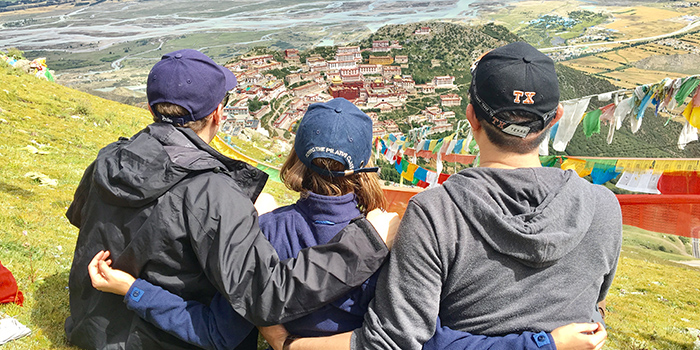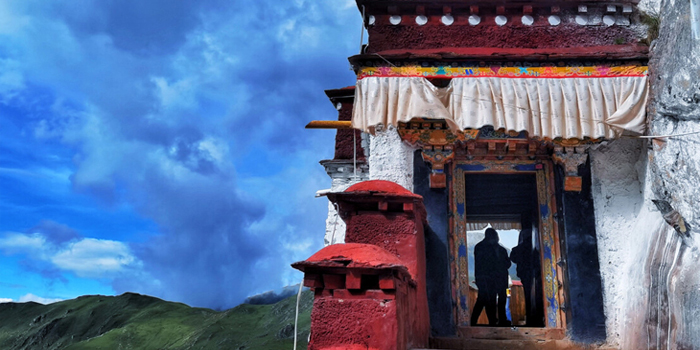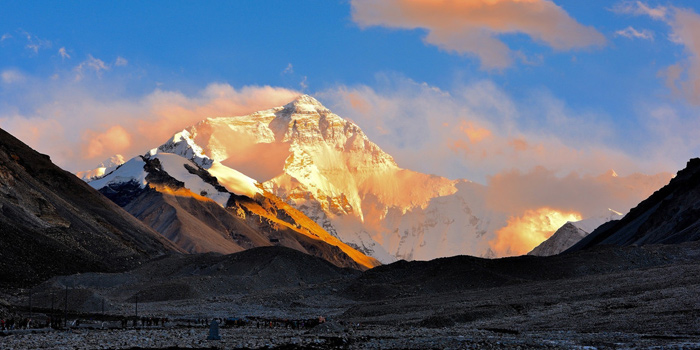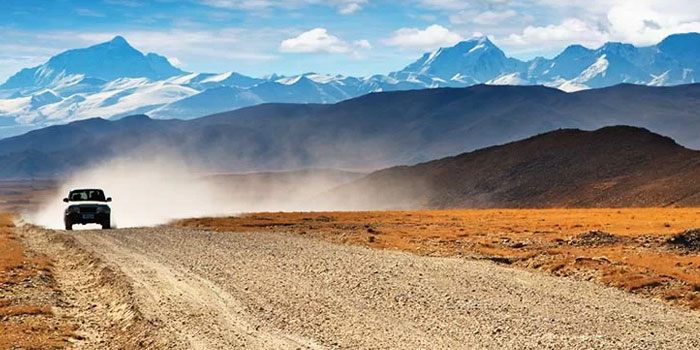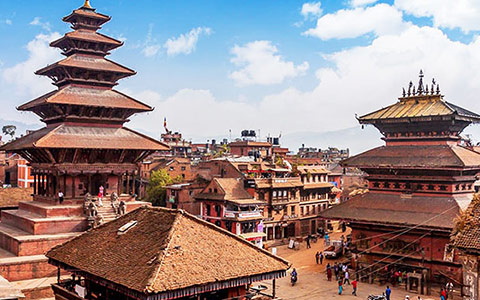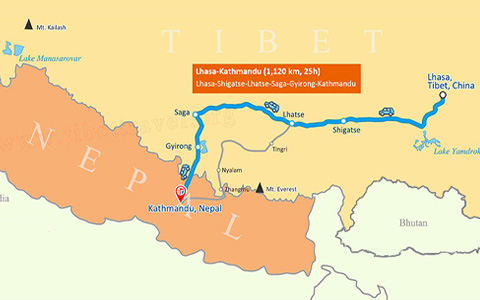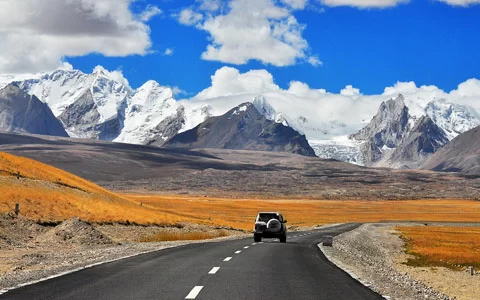10 Most Instagrammable Spots from Lhasa to Kathmandu to Capture Tibet Highlights
The Himalayas and holy Lhasa have long been dream destinations for photographers worldwide. An overland tour from Lhasa to Kathmandu brings you face-to-face with the jaw-dropping Himalayan peaks and mesmerizing Buddhist sites along the way.
If you are a photographer who plans to take this epic Lhasa to Kathmandu overland tour, here are the top 10 most Instagrammable spots for you to capture the majestic landscapes, timeless architecture, and soulful portraits. So, let’s dive into the vibrant colors and rich culture of this magical Himalayan region!
 Potala Palace (3,700m): Capture the Impressive Winter Place of Dalai Lama
Potala Palace (3,700m): Capture the Impressive Winter Place of Dalai Lama
 Barkhor Street (3,650m): Photograph Prostrating Tibetan Pilgrims on the Barkhor Kora Circuit
Barkhor Street (3,650m): Photograph Prostrating Tibetan Pilgrims on the Barkhor Kora Circuit
 Sera Monastery (3,700m): Capture the Vigorous Monk Debate at Sera Monk Debate Courtyard
Sera Monastery (3,700m): Capture the Vigorous Monk Debate at Sera Monk Debate Courtyard
 Ganden Monastery (4,300m): Shoot the Stunning, Sprawling Ganden Monastery on Wangbur Mountain
Ganden Monastery (4,300m): Shoot the Stunning, Sprawling Ganden Monastery on Wangbur Mountain
 Drak Yerpa Monastery (4,400m): Photograph the Mind-blowing Tiger's Nest Lookalike Monastery
Drak Yerpa Monastery (4,400m): Photograph the Mind-blowing Tiger's Nest Lookalike Monastery
 Yamdrok Lake (4,441m): Shoot the Incredible Turquoise Alpine Lake Against Mount Nyenchen Khangsar
Yamdrok Lake (4,441m): Shoot the Incredible Turquoise Alpine Lake Against Mount Nyenchen Khangsar
 Everest Base Camp (5,200m): Capture the Majestic North Face of Mount Everest Up Close
Everest Base Camp (5,200m): Capture the Majestic North Face of Mount Everest Up Close
 Mt. Shishapangma (8,027m): Shoot the Grandeur of Mt. Shishapangma
Mt. Shishapangma (8,027m): Shoot the Grandeur of Mt. Shishapangma
 Pelku Tso Lake (4,591m): Capture the Enchanting Beauty of Pelku Tso Lake
Pelku Tso Lake (4,591m): Capture the Enchanting Beauty of Pelku Tso Lake
 Best Lens Recommended for Photography from Lhasa to Kathmandu
Best Lens Recommended for Photography from Lhasa to Kathmandu
 Travel Service You Need for a Photography Tour from Lhasa to Kathmandu
Travel Service You Need for a Photography Tour from Lhasa to Kathmandu
Potala Palace (3,700m): Capture the Impressive Winter Place of Dalai Lama
Potala Palace is the awesome spiritual and historic icon of Lhasa. Sitting prominently on Red Hill, overlooking the city, its distinctive white and red appearance stands out against the mountains and blue sky.
 Photograph the majestic Potala Palace in Lhasa.
Photograph the majestic Potala Palace in Lhasa.
Shooting Highlights: The grand exterior of Potala Palace has an imposing presence, overlooking the vibrant Lhasa city. You can capture the adornments of the roof and exterior of the White and Red Palace.
Best Shooting Places: Chakpori Hill, Potala Palace Square, Zongjiao Lukang Park, and Lalu Wetland National Nature Reserve.
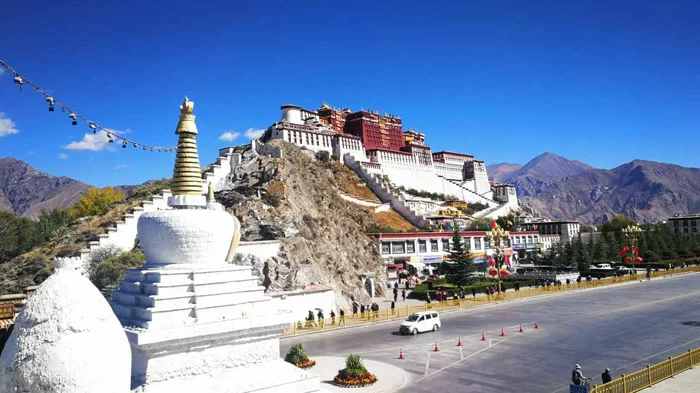 Iconic photos of Potala Palace taken from Chakpori Hill.
Iconic photos of Potala Palace taken from Chakpori Hill.
Best Time for Photography: You can find clear skies most of the year, except for summer, when it rains more frequently. The palace faces south, and the best time to capture front lighting is within an hour of sunrise. Morning is the best time for angles east of the palace, and afternoon is best for photos from the west.
Barkhor Street (3,650m): Photograph Prostrating Tibetan Pilgrims on the Barkhor Kora Circuit
Barkhor Street is the ancient pilgrimage route around Jokhong Temple and home to a bustling marketplace. Dating back over 1,000 years, it has retained its architectural charm and is the cultural heart of the city. Every day, pilgrims can be seen praying and prostrating along the spiritual path.

Shooting Highlights: You can use a telephoto lens to capture devout pilgrims’ devotion being expressed by prostrating themselves or turning the prayer wheels along the route and shooting stunning portraits in the bustling local tea house, etc.
Best Shooting Places: Barkhor Square, Barkhor Circuit, and local teahouses, hidden alleys, and temples, such as Canggu nunnery.
Best Time for Photography: Barkhor Street never closes and the pilgrimage route is always busy, but the morning can be an ideal time to photograph immersive spiritual scenes.
Sera Monastery (3,700m): Capture the Vigorous Monk Debate at Sera Monk Debate Courtyard
Sera Monastery, 2km north of Lhasa, is one of the three great Gelugpa monasteries of Lhasa. It is home to the famous monk debates, a public event where monks debate points of Tibetan Buddhist teachings as part of their education. Part of the tradition is the lively gestures used by debating monks to sway the other side and carry their points.
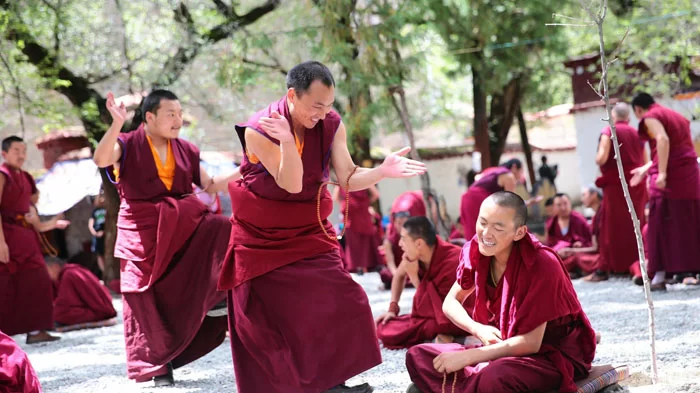 Monk debate at Sera Monastery coutyard.
Monk debate at Sera Monastery coutyard.
Shooting Highlights: Capture photos of monks during the fierce debate. There will be intense exchanges between the debaters, with dramatic gestures and exaggerated expressions.
Best Shooting Places: Debate Courtyard.
Best Time for Photography: The monk debates take place between 15:00 and 17:00 from Monday to Saturday.
Ganden Monastery (4,300m): Shoot the Stunning, Sprawling Ganden Monastery on Wangbur Mountain
Ganden Monastery is another of the three great Gelugpa monasteries in Lhasa. Located in Dagze County, 60km northeast of Lhasa City, the monastery sits in a hilly natural amphitheater on Wangbur Mountain. It is an architectural marvel with intricately decorated temples, prayer halls, stupas, and living quarters for the monks.
 Capture imposing Ganden Monastery from the neighboring mountain.
Capture imposing Ganden Monastery from the neighboring mountain.
Shooting Highlights: The sprawling and massive Ganden Monastery is adorned with golden roofs and intricate decorative elements on photogenic Wangbur Mountain.
Best Shooting Places: Scenic hiking trails with stunning views opposite the Ganden Monastery and along the Ganden Kora route encircling this sacred site
Best Time for Photography: The best weather for visiting is from April to October. The Ganden Thangka Unveiling Festival is a great time to go and capture the crowd of people visiting. It takes place on the 15th day of the 6th month in the Tibetan calendar (July 24, 2024).
Drak Yerpa Monastery (4,400m): Photograph the Mind-blowing Tiger's Nest Lookalike Monastery
Located in the Zhayeba Valley, 32km east of Lhasa, Drak Yerpa Monastery is a holy cave retreat perched on a cliffside in the Yerpa Valley. The nearby meditation caves have been used for centuries as meditation retreats. Like Tiger's Nest in Bhutan, the monastery merges with the hills in a picturesque scene.
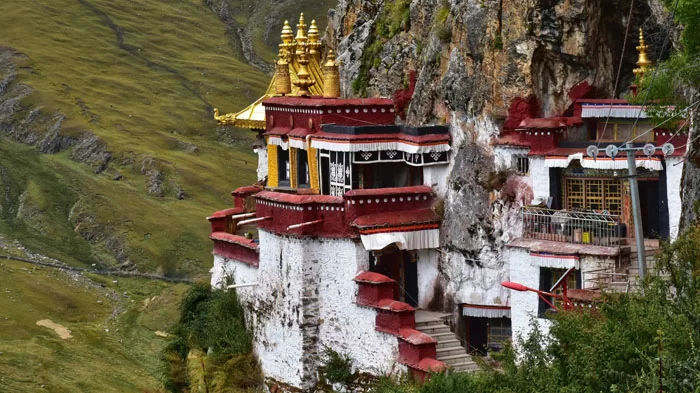 Photograph stunning Drak Yerpa Monastery at cliffside.
Photograph stunning Drak Yerpa Monastery at cliffside.
Shooting Highlights: The iconic white stupas can be photographed against the backdrop of the monastery complex and the main hall against the soaring cliff face.
Best Shooting Places: From below the valley and on the way to Drak Yerpa Monastery.
Best Time for Photography: The monastery can be visited all year round. The best photos of the temples can be taken in the morning.
Yamdrok Lake (4,441m): Shoot the Incredible Turquoise Alpine Lake Against Mount Nyenchen Khangsar
The beautiful Yamdrok Lake is 70km southwest of Lhasa at the southern edge of the Nyenchen Tanglha Mountains. It is one of the Great Three Holy Lakes in Tibet and a stunning tourist attraction on the road from Lhasa to Gyantse. Its turquoise waters cover an area of around 638 square kilometers, surrounded by snow-capped mountains.
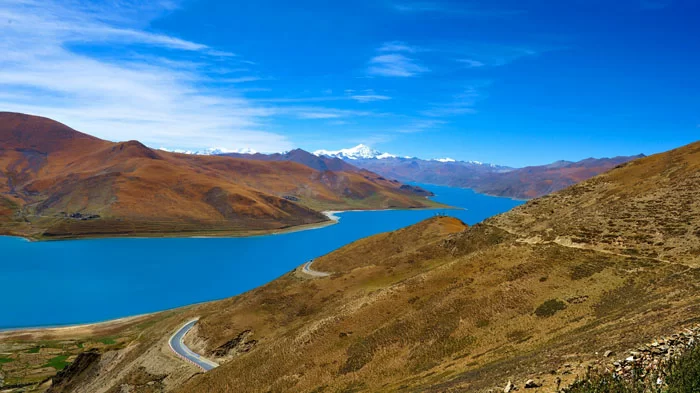 Frame turquoise Yamdrok Lake against snow-capped Mount Nyenchen Khangsar.
Frame turquoise Yamdrok Lake against snow-capped Mount Nyenchen Khangsar.
Shooting Highlights: Capture the mesmerizing hues of Yamdrok Lake's turquoise waters, which change with the light, creating a breathtaking sight. Frame your shots with the majestic Mount Nyenchen Khangsar as a dramatic backdrop against the serene waters.
Best Shooting Places: Kambala Mountain Pass (4,800m) and lake shore.
Best Time for Photography: April to June and September to Nov. are the best times of year to shoot the lake. The early morning sun turns the lake's waters an orange-blue color. Just after sunrise and just before sunset, the glow of the sun over the lake from Kambala Pass is particularly stunning.
Gyantse Dzong (4,020m): Capture the Awe-inspring Gyantse Fortress Overlooking the Idyllic Gyantse County
Perched high above the town of Gyantse, Gyantse Dzong is one of the best-preserved fortresses in Tibet. A Dzong is a distinctive type of fortified monastery with towering exterior walls, watchtowers, and massive entry doors. Gyantse Dzong was built in 1390 and has been the scene of many sieges and battles throughout history.
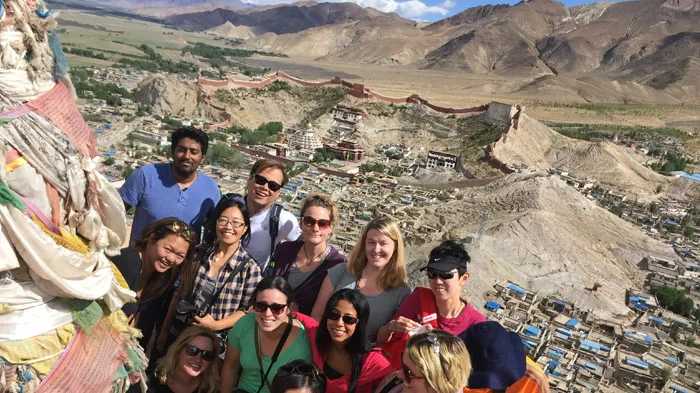 Photograph enchanting Gyantse county from Dzong Fortress.
Photograph enchanting Gyantse county from Dzong Fortress.
Shooting Highlights: In summer, Gyantse Dzong is surrounded by vast grasslands and agricultural fields and you can frame the imposing Gyantse Dzong with exotic Gyantze Kumbum and enchanting Gyantse Town.
Best Shooting Places: From the top of Gyantze Dzong and Palcho Monastery; the surrounding grasslands; the road leading to Gyantse Dzong.
Best Time for Photography: Gyantse is accessible year-round. In the morning and evening, you can get great shots of the sunrise and sunset glow above the surrounding hills.
Gawula Pass (5,200 meters): Photograph the Jaw-dropping Vista of the Five Highest Peaks along the Himalayan Range
Gawula Pass, in Tingri County, Shigatse, is one of the best scene spots for Mount Everest and the soaring peaks of the Himalayas. Located on the way to Everest Base Camp, it gives a view of the five highest Himalayan peaks, averaging above 8,000 meters.
Shooting Highlights: Capture the sweeping panoramic views of the towering Himalayan peaks, including Mount Everest (8,848.86m), Mount Makalu (8,463m), Mount Lhotse (8,516m), Mount Cho Oyo (8,201m), and Mount Shishapangma (8,020m).
Best Shooting Places: The Gawula Pass viewing platform.
Best Time for Photography: It is a popular place to stop. The best time to visit is between 7-8 AM or 6-7 PM to get unobstructed views of the majestic Himalayas.
Everest Base Camp (5,200m): Capture the Majestic North Face of Mount Everest Up Close
It is almost impossible for Mount Everest to not be the highlight for any photographer. On the northern side of the mountain, Everest Base Camp is the closest you can get to the peak of the mighty mountain without actually climbing it.
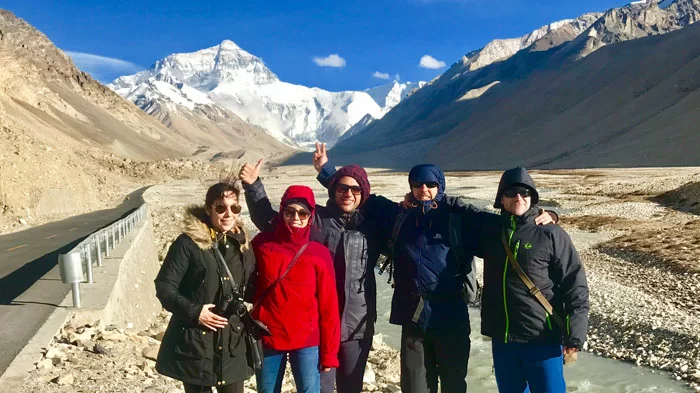 Shoot the north face of Mount Everest at Tibet EBC.
Shoot the north face of Mount Everest at Tibet EBC.
Shooting Highlights: Photograph the iconic golden summit of the unobstructed north face of Mount Everest, the Milk Way above Mount Everest at night, and banner clouds over Mount Everest.
Best Shooting Places: From the camp itself; nearby Rongbuk Monastery and sand dunes.
Best Time for Photography: The single best moments for photos of Mount Everest are views of the Golden Summit one hour before and after sunrise. April and May, and September and October have the best visibility for Mount Everest photography
Mt. Shishapangma (8,027m): Shoot the Grandeur of Mt. Shishapangma
Mt. Shishapangma, in the central Himalayas and fully in Tibet, is the 14th highest mountain in the world and is one of the most accessible 8,000+ meter peaks for climbers. The mountain has a massive pyramid-shaped summit and is surrounded by glaciers and snowfields.
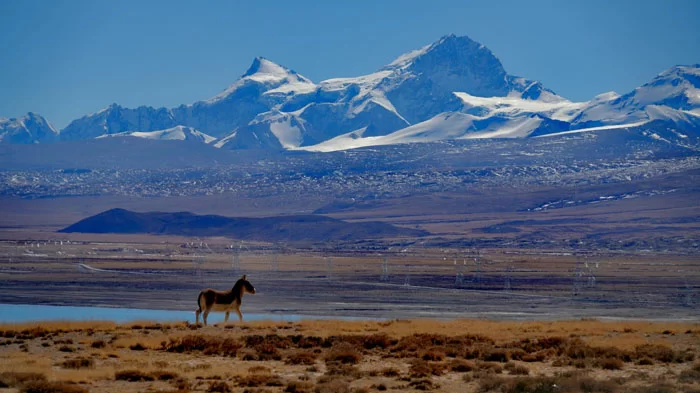 Use a telescope lens to capture the stunning vista of Mt. Shishapangma.
Use a telescope lens to capture the stunning vista of Mt. Shishapangma.
Shooting Highlights: Capture the incredible vistas of Mount Shishapangma towering above the surrounding landscape from the roadside.
Best Shooting Places: Southwest base camp, Pelku Tso Lake, Kong Lake.
Best Time for Photography: Visibility is best in April and May, and September and October without being too cold. An hour before sunrise and after sunset, the mountain is beautifully lit by the sun.
Pelku Tso Lake (4,591m): Capture the Enchanting Beauty of Pelku Tso Lake
Pelku Tso Lake is a stunning, clear lake surrounded by mountains on three sides. Located in Shigatse Prefecture, the lake is home to rare birds and native species like the Tibetan wild donkey. Although 60 kilometers to the south, the reflection of Mount Shishapangma can be captured on the lake waters.
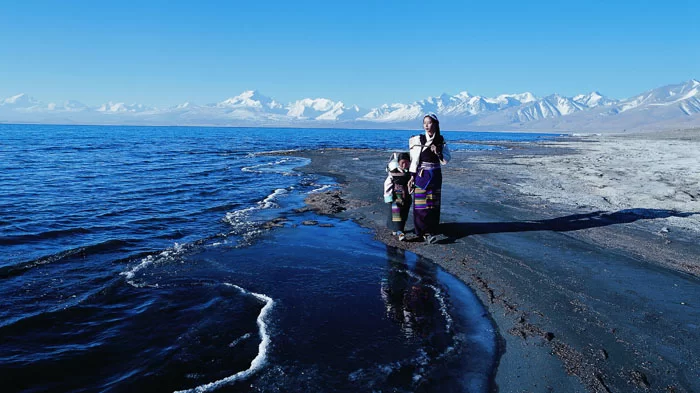 Peiku Tso Lake and Mount Shishapangma vista.
Peiku Tso Lake and Mount Shishapangma vista.
Shooting Highlights: Photograph great views of Mount Shishapangma with the Pelku Tso Lake in the foreground; Wild donkeys, black-necked cranes, and red-billed gulls are among the many native animals that live around the lake.
Best Shooting Places: Lakeshore.
Best Time for Photography: April-May and September-October have the best conditions for visiting the lake. The early morning sun illuminates the rich color of the water.
Best Lens Recommended for Photography from Lhasa to Kathmandu
You want to use a full-frame DSLR, 24-70mm F2.8, 70-200mm F2.8, 14-24mm F2.8, and 85mm F1.4 to capture the range of angles needed to show the full dimensions of Tibet's natural wonders. If you want to travel light, 24-120mm F.4 can be the best option.
Daytime in Tibet, the sun can be intense. You can mount your lens with an ND filter to keep the aperture wider to achieve a shallower depth of field for artistic effect while maintaining proper exposure.
 Use a 70-200mm telescope lens to capture distant mountains with great details.
Use a 70-200mm telescope lens to capture distant mountains with great details.
Travel Service You Need for a Photography Tour from Lhasa to Kathmandu
Last, certainly but not least, since independent travel is not an option for overseas travelers. You can book your 7-day Lhasa to Kathmandu overland small group tour or custom your Tibet tour with us, a prestigious local Tibet travel agency
Then, we can help you secure the Tibet Travel Permit to enter Tibet and travel with our seasoned local Tibetan photography expert to enjoy the photography tour.
Conclusion:
The overland journey from Lhasa to Kathmandu is packed with opportunities for unique and stunning photography. Don't miss out on any of the amazing sites in Lhasa, the Himalayas, or the Kathmandu Valley. If you have more questions, please feel free to email us for free and expert travel advice. Cheers!
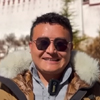
Jamyang Tsering, one of our senior travel guides, has a wealth of experience spanning nearly 20 years. Also a celebrated YouTuber for our Tibet Vista channel, Jamyang is genuinely enthusiastic about showing the REAL Tibet to both our customers and fans. It could be an interesting experience to explore Tibet with Jamyang.
Related Articles & Posts
Most Popular Tibet Tour Packages
-

Lhasa - Gyantse - Shigatse - Everest Base Camp - Shigatse - Lhasa
USD939
View Details -

Lhasa - Gyantse - Shigatse - E.B.C - Saga - Kailash Trek - Darchen - Lake Manasarovar - Saga - Gyirong - Tingri - Lhasa
USD2059
View Details -

10 Days Lhasa to Everest Base Camp and Namtso Lake Small Group Tour
Lhasa - Gyantse - Shigatse - EBC - Shigatse - Lhasa - Namtso Lake - Damxung - Lhasa
USD1289
View Details -

8 Days Driving Across Himalaya Overland Adventure from Kathmandu to Lhasa
Kathmandu - Gyirong - Everest Base Camp - Tingri - Shigatse - Gyantse - Lhasa
USD1069
View Details -

4 Days Lhasa Impression Small Group Tour: Explore the Heart of Tibet and Mingle with the Locals
Lhasa
USD509
View Details -

Lhasa - Gyantse - Shigatse - Everest Base Camp - Gyirong - Kathmandu
USD979
View Details -

Lhasa - Gyantse - Shigatse- Lhasa
USD799
View Details -

13 Day Lhasa, Mt. Everest, Mt. Kailash, Lake Manasarovar and Kathmandu Adventure Tour
Lhasa - Gyantse - Shigatse - EBC - Saga - Darchen - Kailash Trek - Darchen - Saga - Gyirong - Kathmandu
USD2059
View Details


.jpg)



